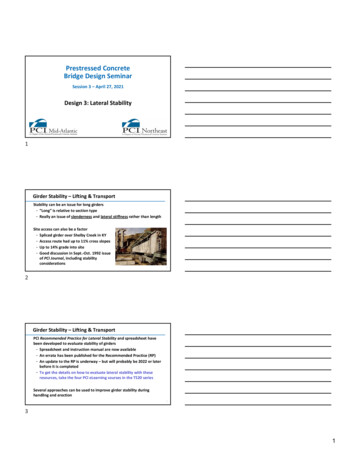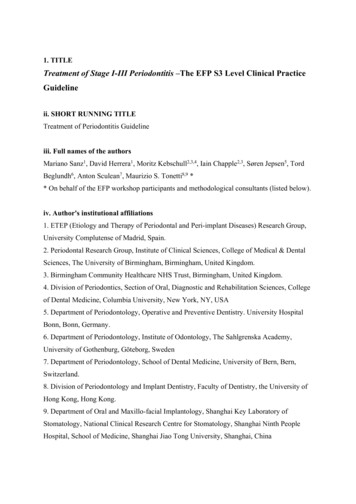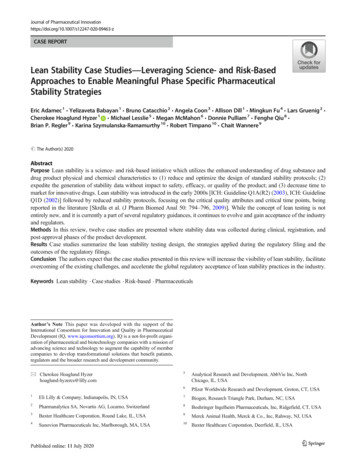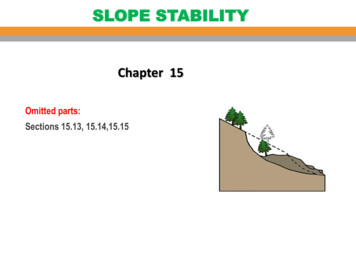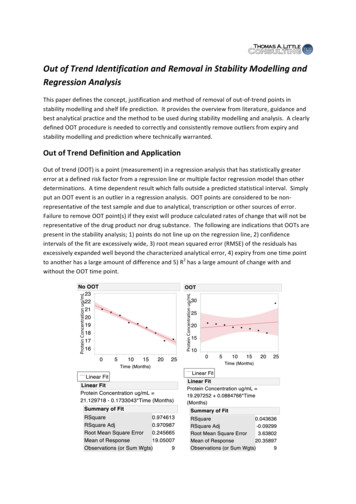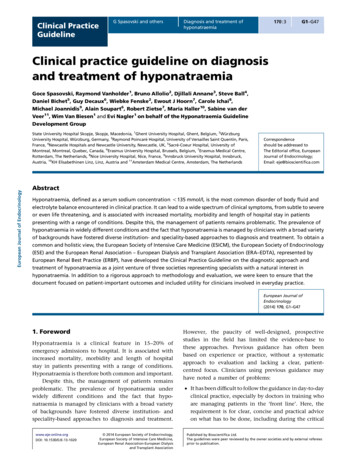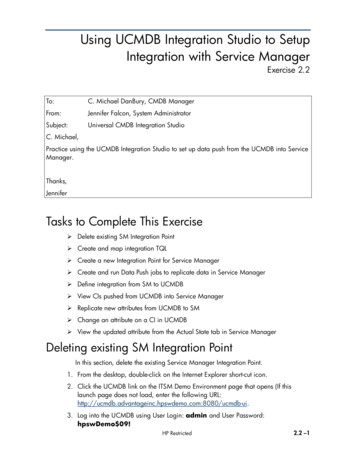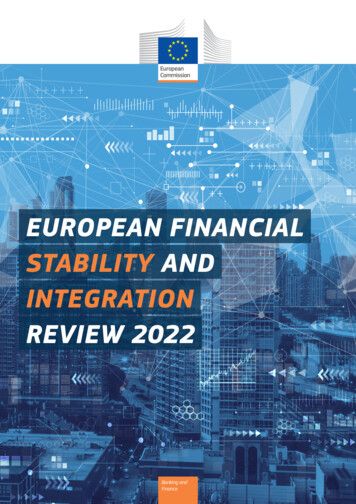
Transcription
EUROPEAN FINANCIALSTABILITY ANDINTEGRATIONREVIEW 2022Banking andFinance
An interactive version of this publication, containing links to online content, is available inPDF format at:https://europa.eu/!tgTpjBEuropean Financial Stability and Integration Review 2022scan QR code to downloadEuropean CommissionDirectorate-General for Financial Stability, Financial Services and Capital Markets UnionEuropean Commission1049 Bruxelles/BrusselBelgium European Union, 2022Reuse is authorised provided the source is acknowledged. Distorting the original meaning or message of thisdocument is not allowed. The European Commission is not liable for any consequence stemming from the reuseof this publication. The reuse policy of European Commission documents is implemented by the CommissionDecision 2011/833/EU of 12 December 2011 on the reuse of Commission documents (OJ L 330, 14.12.2011, p.39).For any use or reproduction of photos or other material that is not under the copyright of the European Union,permission must be sought directly from the copyright holders.All images European Union, 2022, except:cover photo: Tierney - stock.adobe.com
EUROPEANCOMMISSIONBrussels, 7.4.2022SWD(2022) 93 final/2CORRIGENDUM:This document corrects document SWD(2022) 93 final of 4.04.2022Correction of layout mistakes only.The text shall read as follows:COMMISSION STAFF WORKING DOCUMENTEuropean Financial Stability and Integration Review (EFSIR)ENEN
This document has been prepared by the European Commission’s Directorate-General forFinancial Stability, Financial Services and Capital Markets Union (DG FISMA).This document is a European Commission staff working document for information purposes. Itdoes not represent an official position of the Commission on this issue, nor does it anticipatesuch a position. It is informed by the international discussion on financial integration andstability, both among relevant bodies and in the academic literature. It presents these topics ina non-technical format that remains accessible to a non-specialist audience. For informationon the methodology and quality underlying the data used in this publication for which thesource is neither Eurostat nor other Commission services, users should contact the referencedsource.1
CONTENTS1.1Macroeconomic developments . 81.2Financial-market developments . 101.3Financial stability . 131.4Financial integration . 172.1Introduction . 242.2Real estate market developments and vulnerabilities since the global financial crisis 252.3Policies to address systemic risks in real estate markets . 332.4Concluding remarks and policy considerations . 413.1What is decentralised finance (DeFi)?. 433.2State of the market development in Europe. 453.3Current functionalities of DeFi . 473.4How DeFi works . 533.5Policy considerations . 552
ACKNOWLEDGEMENTSThis document was prepared by the European Commission’s Directorate-General for FinancialStability, Financial Services and Capital Markets Union (DG FISMA) under the direction ofJohn Berrigan (Director-General) and Klaus Wiedner (Director, Financial system surveillanceand crisis management).The production of the document was coordinated by the editor Geert Van Campenhout.Principal contributors were (in alphabetical order) Chris Bosma, Ramona Jimborean, GundarsOstrovskis, Arien Van't Hof, Mariana Tomova, Vincent O’Sullivan, Geert Vermeulen andChristoph Walkner.Several colleagues from DG FISMA and other parts of the Commission provided comments,suggestions or assistance that helped to improve the text. We are particularly grateful to (inalphabetical order) Leonie Bell, Jan Ceyssens, Ojea Ferreiro, Peter Grasmann, MaxLangeheine, Jung-Duk Lichtenberger, Ralf Jacob, Stan Maes, Alessandro Malchiodi, MichelaNardo, Rosati Nicoletta, Nicola Negrelli and Almorò Rubin De Cervin.Comments are welcome and can be sent to:Directorate-General for Financial Stability, Financial Services and Capital Markets Union(DG FISMA)Unit E1: EU/euro-area financial systemUnit E4: Economic analysis and evaluationEuropean Commission1049 BrusselsBelgiumOr by email to leonie.bell@ec.europa.eu or peter.grasmann@ec.europa.eu.3
LIST OF ABBREVIATIONSCountries (in alphabetical niaAustriaBelgiumBosnia and coRepublic of North tugalRomaniaSwedenSingaporeSloveniaSlovakiaUnited KingdomUnited based measuresBank for International SettlementsBasis pointsCommercial real estateCapital Requirements RegulationDecentralised autonomous organisationDistributed ledger technologiesDebt service to incomeDebt-service-to-incomeDebt to incomeEuro uropean Central BankForeign direct investmentsGross domestic productPIRERREHarmonised index of consumer pricesInitial coin offeringInternational Monetary FundLoan to incomeLoan to valueMortgage Credit DirectiveMacroeconomic Imbalances ProcedureNon-financial corporationNon-fungible tokenNon-performing loansOrganisation for Economic Co-operationand DevelopmentPortfolio investmentsReal estateResidential real estateOthers4
EXECUTIVE SUMMARYPublished annually, the European Financial Stability and Integration Review looks at recenteconomic and financial developments and discusses some specific issues pertaining to thefinancial sector that might pose challenges to financial integration and stability and also raisepolicy issues.Chapter 1 reviews the economic recovery from the COVID-19 pandemic and discussesfinancial stability and integration in the EU, in particular the developments in 2021. Therecovery was strong but uneven across industries and Member States and remains dependent onhow the pandemic, rising inflationary pressures and the crisis stemming from the Russianinvasion of Ukraine evolve. Inflation was stronger and stickier than expected in 2021, fuelledby global demand, supply constraints and rising energy prices.European and global economic activity rebounded strongly in 2021, following the deepCOVID-19 recession that started in 2020. In 2021, GDP grew by 5.3% in both the EU and theeuro area, despite a slowdown towards the end of the year due to supply bottlenecks, sharplyrising energy prices and increased COVID infections. Rising infection rates and morecontagious coronavirus variants forced many Member States to tighten containment measuresagain, illustrating that the coronavirus has not entirely lost its hold on the EU economy.Financial markets were resilient and stock markets performed strongly throughout 2021,despite some bouts of volatility. Investors were willing to take on risk, prompted by lowinterest rate levels and recovery, fiscal and accommodative monetary policy measures.However, in the beginning of 2022, investors started to become more concerned about thereduced monetary policy support by central banks amid the strong rise in inflation (andinflation expectations). Moreover, in February 2022, risk asset markets tanked severely,following the rapid escalation of the Ukrainian crisis and the Russian invasion. Marketvolatility increased significantly and prices of financial assets, including European share prices,fell. Share prices of the banking sector underperformed, in particular of those EU banks that aremore strongly exposed to Russia. The uncertainty surrounding military escalation and itsimplications for the real economy and financial markets is expected to be the dominating factorthat determines how markets will evolve in the short term.In 2021, financial stability risks receded somewhat but remained elevated. Policy measureshelped to stabilise the financial sector, but several vulnerabilities remain, such as high levels ofcorporate debt, increasing sovereign debt and rapid rises in real estate prices. Threats tofinancial stability stem mainly from risks related to (i) a disruptive repricing in major financialmarket asset classes, (ii) renewed balance-sheet stress in the non-financial corporate sector orthe household sector, and (iii) a resurgence of stress in parts of the EU banking sector. Howvulnerabilities will develop will strongly depend on the outlook for growth, inflation andinterest rates.The conflict in Ukraine is likely to slow down EU growth and raise inflation in the comingmonths. This will hamper the correction of existing imbalances and contribute to somefinancial stability risks. At the time of writing, the direct effect on EU financial markets andinstitutions is expected to be limited. Exposure to, and financial linkages with, Russiancounterparties are in general relatively small compared to the overall depth of EU financialmarkets, and have in many cases even receded since 2014. However, there are risks that could5
affect the EU financial system, also depending on the further development of the situation inUkraine on the ground. In particular, indirect effects via foreign trade and investment andpossible dislocations of some market segments, including energy spot and derivatives markets,might very well materialise and could further accentuate pressure on financial asset prices orthe proper functioning of some segments of financial markets.Following the COVID-19 pandemic, financial integration resumed at a substantially faster pacethan after previous crisis episodes, thanks to the prompt policy response and the positive effectof longer-term regulatory and institutional reforms. Price-based and quantity-based financialintegration measures fully recovered by Q3 2021, although the longer-term effects of thepandemic remain to be seen. From a policy perspective, it remains important to monitor sectorspecific developments and analyse structural changes in the financial system, including thosethat might emerge in response to the digital and green transition.Chapter 2 reviews key developments and systemic risks in the EU real estate sector since theglobal financial crisis. Real estate prices have been rising strongly in most Member States inrecent years, a trend showing few signs of abating. The current risks posed by real estate tofinancial stability remain high. The increase of vulnerabilities and the risk of a correction inthese markets is one of the main medium-term systemic risks, especially in Member States withelevated household debt levels, high bank exposures to real estate markets and overvaluedproperties, although a significant residential real estate (RRE) price correction is in the shortterm partly mitigated by supply side constraints. The build-up of medium-term vulnerabilitiesin EU residential real estate markets warrants continued close monitoring by national andEuropean authorities, given that housing and credit booms and busts have triggered majorbanking and financial crises in the past.Macroprudential tools have been introduced in the aftermath of the global financial crisis tolimit system-wide risks in the EU banking sector. Many Member States have responded torising real estate market vulnerabilities by adopting macroprudential measures to curbimprudent lending and bolster bank resilience to real estate shocks. Member States mostly usetighter capital requirements and borrower-based instruments such as loan-to-value (LTV) anddebt-service-to-income (DSTI) limits. A few Member States temporarily relaxed certain ofthese measures in response to the COVID-19 crisis.In recent years, the approach of Member States to address real estate risks throughmacroprudential policy instruments has converged. However, significant differences remain,for instance with respect to how capital and borrower-based measures are calibrated anddesigned. This diversity, and other factors such as the impact of climate-related financial risks,need to be considered as part of the further development of macroprudential policies for realestate risks in the EU and in the context of the ongoing review of the EU macroprudentialregulatory framework.Chapter 3 discusses decentralised finance (DeFi), which is an emerging form of autonomousfinancial intermediation in a decentralised digital environment, powered by open sourcesoftware. DeFi seems to replicate key features of the traditional financial system throughinnovative solutions adapted for the blockchain environment. Lending applications currentlyrepresent the widest use in DeFi, followed by decentralised exchanges. While still very smallcompared to the size of the traditional financial sector, DeFi is growing rapidly, and the chapteraims to provide an overview of the relevant issues that need to be closely monitored.6
Compared to the traditional financial system, DeFi could potentially increase the security,efficiency, transparency, accessibility, openness and interoperability of financial services. As aresult, DeFi could provide substantial opportunities to foster cross-border financial integration,which is an important policy objective of the EU. It could also enhance financial stability viarisk sharing, which is rooted in its decentralised governance and liquidity provision. While itscontribution to the financing of real economic activity is so far minimal, it is already proving tobe useful in the virtual economy.However, the DeFi ecosystem is subject to many risks, notably conduct and operational risks.Conduct risks arise in the absence of any regulation and are amplified by the quasi-anonymousnature of DeFi, whereas operational risks occur in view of the vital part played by software.Continued rapid growth of the DeFi ecosystem could also have future financial-stabilityimplications in light of the prominent role played by stablecoins. Adapting the EU financialservices regulatory framework to a decentralised environment will require a rethink; andregulatory cooperation with the main jurisdictions relevant to the DeFi ecosystem might proveindispensable. To benefit from the inherent data transparency on public blockchains, theCommission announced that it would launch a pilot project on embedded supervision1 in 2022.Overall, any future policy action should balance the risk of curtailing innovation versus therisks that the DeFi ecosystem may pose and the public policy benefits that regulatoryintervention is expected to bring.1See Communication from The Commission to the European Parliament, the Council, the European Economic and SocialCommittee and The Committee of the Regions, Strategy on supervisory data in EU financial services, COM/2021/798 finalof 15 December 2021.7
Chapter 1 THE MACRO-ECONOMY, MARKET DEVELOPMENTS, FINANCIAL STABILITY ANDFINANCIAL INTEGRATIONAfter the COVID-19 outbreak, the EU plunged into its steepest recession since World War II,but European and global economic activity rebounded strongly in 2021. As the vaccination rollout gathered steam, containment measures were gradually lifted, although some weretemporarily re-introduced due to renewed spikes in COVID-19 infections. Consumption andinvestment in 2021 continued to benefit from highly supportive fiscal and monetary policies,including unprecedented stimulus packages in response to the pandemic, combined with pentup demand and surplus household savings accumulated due to lockdowns and otherrestrictions. Although the recovery remains partial and uneven, thanks to stronger-thanexpected global growth major developed economies – including most EU Member States –have been able to recoup their pre-crisis output level over the course of 2021 (see Chart 1.1 andChart 1.2). Future developments are subject to elevated risks caused predominately by theeconomic impact of the crisis in Ukraine and the uncertain development of the pandemic.Chart 1.1: Real GDP – major global economiesChart 1.2: Real GDP – EU Member 080702020EU-272021EA-192022United States2023China2020GermanyItalyWorldSource: OECD, Eurostat, European Commission (2022),European Economic Forecast Winter 2022, InstitutionalPaper 169, February 2022.Note: Quarterly data, indexed (Q4 2019 100). Forecasts predate the Ukraine crisis escalation in late February e: Eurostat, European Commission (2022), EuropeanEconomic Forecast Winter 2022, Institutional Paper 169,February 2022.Note: Quarterly data, indexed (Q4 2019 100). Forecasts predate the Ukraine crisis escalation in late February 2022.Overall, GDP grew by 5.3%2 in both the EU and the euro area in 2021. At the start of 2021,economic activity flat-lined, as most Member States were still in partial lockdown in responseto a spike in infections over the winter months. Specifically, EU (seasonally adjusted) GDPremained roughly unchanged in Q1 2021 compared with the previous quarter. Following thistrough, economic momentum picked up rapidly in spring, which was reflected in consumer andbusiness survey data that recovered sharply and reached record highs in the summer. EU GDPgrew by 2.1% and 2.2% quarter-on-quarter (q-o-q) in the second and third quarter. Yet, thecombination of continuing supply bottlenecks, sharply rising energy prices and a renewed pick2Based on preliminary national accounts data for Q4 2021.8
up in COVID infections resulted in a slowdown of GDP growth in the EU to 0.4% q-o-q in thefourth quarter. Consistent with this, sentiment indicators declined somewhat in late 2021.Overall, corporate survey data remain broadly upbeat by historical standards (Chart 1.3).Concerns about new COVID variants and higher energy prices, among other things, howeverfurther weakened consumer sentiment in the beginning of 2022.Inflation pressures were stronger and stickier than expected. Headline inflation in the euro areahovered at around 1% y-o-y at the start of 2021, but started to rise steadily from the spring toreach 5.8%3 y-o-y in February 2022. This is the highest rate since the early 1990s, and wellabove the European Central Bank’s 2% target. Although this acceleration was partly driven bya sharp rise in energy prices, core inflation also increased to 2.7% y-o-y as of February,pointing to general pressure on consumer prices. Consumer price inflation accelerated toabove-target levels also in most other regions in the world. This global trend is largely due tothe combination of strong and rapid recovery in global demand and ongoing supply constraints.The demand growth was fuelled by the reopening of major economies, while many industriessuch as semiconductors, building materials or commodities were still confronted with supplyconstraints. This was compounded by logistical bottlenecks. For instance, ports had to closebecause of local lockdowns or a lack of shipping capacity. Inflation was also pushed up by ashift in demand from services to goods during the pandemic, partly because capacity for goodsis more difficult to expand in the short term. This pressure eased but did not fully unwind atthis moment. Although inflation is expected to gradually decline in the upcoming years assupply bottlenecks progressively subside (see Chart 1.4), some sources of upside risk arepresent, including the impact of the crisis in Ukraine on energy and other commodity prices andthe fact that wage growth might accelerate4.EU labour market developments mirrored the overall trend in economic activity. After a‘double dip’ in the first quarter due to pandemic containment measures, labour demand startedto recover strongly from the spring onwards. By Q4 2021, headcount employment grew by2.2%, equivalent to about 4.6 million workers, relative to the first-quarter trough. Theunemployment rate declined from 7.5% at the start of 2021 to 6.2% in January 2022, an alltime low. However, broader measures of labour market performance suggest that some slackremains. For instance, average hours worked have not fully recovered from the impact of thepandemic and remain about 4% below their end-2019 level, and the underemployment rate(which also includes involuntary part-time workers and those on the fringes on the labourmarket) remains 0.4 percentage points above its historical low. Consistent with this, wagegrowth remains fairly muted, with negotiated wages5 in the euro area having grown by 1.5%y-o-y as of Q4 2021. Nevertheless, there are more and more signs that the labour market istightening. For instance, in many sectors the vacancy rate is well above pre-pandemic levelsand it has become harder for firms to hire people.345Based on preliminary data releases.Although there are currently little signs of strong second-round effects via higher wages, increasingly tight labour markets(see below) combined with the impact of automatic wage and social benefits indexation in some Member States suggest thatthere may be growing risks of second-round dynamics taking hold.The index of euro-area negotiated wages is a better measure of underlying wage growth than compensation-per-employeestatistics which are distorted by the impact of employees transitioning out of job retention schemes.9
Chart 1.4: HICP inflation – EU Member StatesChart 1.3: Euro-area business and consumersentiment 0-200%100201920202021-25-2%2022PMI manufacturingPMI servicesConsumer confidence (rhs)Source: IHS Markit, European Commission (2022), Business andconsumer survey results, DG ECFIN, 25 February 20226.Note: Monthly data, index erlandsPoland2023Source: Eurostat, European Commission (2022), EuropeanEconomic Forecast Winter 2022, Institutional Paper 169,February 2022.Note: Headline data, y-o-y % change. Monthly data, exceptforecasts (quarterly data). Forecasts pre-date Ukraine crisisescalation in late February 2022.Despite the robust economic rebound, the recovery remains partial and uneven across industriesand among Member States. Economic developments have varied widely across industrysectors, with a notable difference in performance between manufacturing and services(see Chart 1.3). Contact-intensive sectors such as hospitality and travel were especially hard hit.The severity of the pandemic was different between Member States, and also the recovery hasbeen uneven due to differences in economic structure7 and different policy approaches, forinstance in terms of pandemic containment measures or in the fiscal impulse. In particular forsouthern European Member States with substantial cross-border tourism sectors, the initialGDP contraction was sharper than average and the recovery comparatively slower. As a result,Q4 2021 GDP in Spain, Portugal and Italy remains well below the Q4 2019 level, although it isexpected that these three Member States will be able to close the gap in 2022. Overall, thepandemic has exacerbated economic divergence across countries.Financial markets remained resilient throughout 2021, despite a challenging environment andsome bouts of volatility. Concerns about the way that the pandemic would affect economicgrowth (expectations) and uncertainty around its virus variants weighed on markets, mostly inthe first half of the year. Over the summer, concerns emerged about the weakening Chinesegrowth momentum, fuelled by the case of the troubled Chinese construction giant, Evergrande,early September, and its spillover risks to the EU. The dominant theme in the latter half of theyear was rising inflationary pressures, but investors remained willing to take a risk-on stance inview of the very supportive monetary, fiscal and prudential policy measures in place. umer-survey-data/time-series enThis is especially the case for the relative weight of contact-intensive services industries.10
willingness to take risks was further supported by the ongoing recovery and its positive impacton corporate earnings. In the beginning of 2022, investors started to become more concernedabout the reduced monetary policy support by central banks amid the strong rise in inflation(and inflation expectations). Finally, the crisis in Ukraine made investors more risk averse amida spike in volatility across asset classes. EU financial markets have reacted quite sharply,experiencing falling asset prices and higher volatility. European stock indexes hit nearly oneyear lows. The banking sector underperformed and a handful of EU banks with directexposures to Russia had significant losses. The uncertainty surrounding military escalation andthe fear for negative implications for the real economy and for financial markets is expected todominate market evolutions in the short term.In sovereign bond markets, the euro-area (EA) benchmark (German Bund) mid- and long-termnominal yields gyrated higher over 2021, driven by the ongoing economic recovery and bysignificantly rising market-implied inflation expectations for the EA. The 10-year GermanBund yield started the year at around -0.60% and closed the year at -0.13%, while the real10-year Bund yields declined from -1.48% to an historically very low -2.00%. The ECB policystance proved to be effective in keeping nominal bond yields in check, even in the face ofincreasing inflation. Several factors such as the sustained asset purchases by the ECB under thepandemic emergency purchase programme (PEPP) and the asset purchase programme (APP)contributed to this. In addition, the ECB (and other central banks) persistently signalled thatfresh measures might be brought in to support the economy if needed. Finally, there was theexplicit recognition that some of the ‘exceptional’ monetary policy measures like forwardguidance, asset purchases and targeted longer-term refinancing operations (TLTROs) are nowofficially part of the standard toolbox. In early 2022 the 10-year Bund yield was positive again,and this for the first time since January 2019. This increase was driven by a rise in real yieldsamid the prospects of higher growth and a tighter monetary policy stance. This trend wasalready reversed by the end of February as investors fled towards low-risk assets in response tothe Ukrainian crisis, despite climbing market-implied inflation expectations.Chart 1.5: Sovereign bonds yields and expectedinflationChart 1.6: Sovereign bond spreads3%basis an 20 May 20 Sep 20 Jan 21 May 21 Sep 21 Jan 2200%-1%Jan 20May 20DE YieldSep 20US YieldJan 21May 21DE InflationSep 21Jan 22US InflationSource: Bloomberg.Note: 10-year maturity bond data. Daily data. 10-year inflationexpectations based on the break-even inflation rate oninflation-linked bonds.DEES (rhs)FR (rhs)IT (rhs)Source: Bloomberg. DG FISMA calculations.Note: Spreads are calculated against the 10-year German Bund.11
Chart 1.7: Stock market performanceChart 1.8: Euro-area corporate bond spreads1200150basis points250120015010001302001000130800 110150800 110600 90100600400 7050400200 50Jan 20May 20Sep 20Eurostoxx 600US S&P 500Stoxx Asia Pacific 600Jan 21May 21Sep 210Jan 20Jan 22EU Banks indexHang Seng CompositeSource: Bloomberg.Note: Daily data, indexed (Jan 2020 100).200May 20Sep 20AAJan 21 May 21ABBBSep 21Jan 22HY (rhs)Source: Bloomberg. DG FISMA calculations.Note: 5-year maturity bond data. Daily data. Spreads arecalculated against the 5-year German sovereign bond yield.HY stands for high yield.EA sovereign bond spreads widened vis-à-vis the German Bund benchmark in particulartowards the end of 2021 and the beginning of 2022 in view of the expected lower monetarypolicy support. Ten-year bond spreads to the Bund for non-EA Member States’ bonds widenedsignificantly amid a strong upswing in inflation, followed by responsive central bank policies.In corporate credit markets, bond spreads in the investment grade and high-yield segmenttightened further in the first half of 2021, resulting in a strong increase in corporate bondissuances in the primary market. However, since 2022, corporate bond spreads in all risksegments have widened strongly. Some existing bonds may be particularly exposed to interestrate risk as they have been issued with very low coupons in view of the low interest rateenvironment.Stock markets performed strongly in 2021, in particular in the first half of the year, in line withthe recovery of the economy. In the second half of the year, stock markets swung increasinglyon a risk-on/risk-off investors’ mode. Main market drivers were, on the one hand, strongcorporate earnings, and, on the other hand, concerns over the impact of the COVID-19 variantson the economic outlook, a possible earlier-than-expected scaling back of bond purchasingprogrammes by central banks and mounting inflation pressures amid a rise in energy prices andsupply chain disruption in the manufacturing sector. Over 2021, the Europe 600 index gained22%. A major sector r
implications for the real economy and financial markets is expected to be the dominating factor that determines how markets will evolve in the short term. In 2021, financial stability risks receded somewhat but remained elevated. Policy measures helped to stabilise the financial sector, but several vulnerabilities remain, such as high levels of

